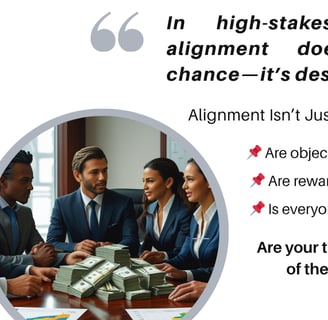Aligning Incentives for Tangible Results
Blog post description.
6/5/20252 min read


💬 “In high-stakes transformations, alignment doesn’t happen by chance — it’s designed.”
In complex corporate transformations — restructurings, integrations, turnarounds — success rarely depends on strategy alone. It hinges on execution. And execution depends on people. The right ones, doing the right things, for the right reasons.
Yet, in practice, many transformation efforts stall not for lack of planning or intelligence, but because of a fundamental misalignment between those driving the change and those impacted by it.
I've seen this pattern across deals, industries and regions: you bring in a reputable advisory firm or form a taskforce of internal high-performers, you set a clear goal, and everyone nods in agreement. But six months in, you’re behind schedule, over budget, and the energy has vanished.
Why? Because there’s no true alignment. At least, not the kind that matters when pressure builds.
Let’s be clear: alignment isn’t just about culture or communication. It’s about incentives, accountability, and ownership.
The Real Cost of Misalignment
Private equity investors and senior executives know this intimately. The most expensive failures are rarely strategic. They’re operational.
• When advisors are measured by billable hours rather than outcomes, you get more slide decks than decisions.
• When internal teams are expected to “own” the transformation without having a stake in its success, things drift.
• When interim execs are treated as placeholders, not partners, momentum fades fast.
In transformations where speed, trust and impact matter, traditional models of compensation and engagement often fall short. They create an illusion of progress, but fail to drive true accountability.
Three Questions That Change the Game
Before engaging anyone—be it a consultant, interim executive, or internal team lead—ask yourself:
📌 Are the objectives genuinely transparent?
Or are there layers of politics and ambiguity that will stall execution down the line?
📌 Are incentives tied to value creation, not just activity?
Because rewarding effort instead of outcomes is a recipe for delay and dilution.
📌 Is there real risk-sharing—or just lip service?
When partners share the upside and some of the downside, behaviour changes. Fast.
When these questions are answered properly—at the briefing, not just the debriefing—results tend to follow. Accountability shifts from being a KPI discussion to becoming instinctive behaviour. Trust builds faster. Execution sharpens.
Skin in the Game Changes the Conversation
In my experience, transformation efforts work best when partners are treated… as actual partners. When advisors are rewarded for delivering, not just advising. When interim execs have room to lead—and reason to win. When internal leaders see that their commitment will translate into recognition and results.
That kind of alignment isn't fluffy. It's structural. And yes—it can be contractual.
• Performance-based fees.
• Clear KPIs linked to compensation.
• Milestone-based engagement reviews.
• Flexibility to pivot roles based on execution needs.
These aren’t radical ideas. But they’re often avoided because they’re uncomfortable—for both sides. They require transparency, maturity, and a shared belief that the transformation is worth doing well.
Final Thought: Are They Just Along for the Ride?
If you’re about to launch (or relaunch) a high-stakes transformation—ask yourself:
👉 Are your transformation partners truly aligned with your outcomes?
👉 Or are they just delivering the process and sending the invoice?
The difference shows up in the results. Every time.
